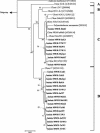Isolation of strains belonging to the cosmopolitan Polynucleobacter necessarius cluster from freshwater habitats located in three climatic zones
- PMID: 12957910
- PMCID: PMC194981
- DOI: 10.1128/AEM.69.9.5248-5254.2003
Isolation of strains belonging to the cosmopolitan Polynucleobacter necessarius cluster from freshwater habitats located in three climatic zones
Abstract
More than 40 bacterial strains belonging to the cosmopolitan Polynucleobacter necessarius cluster (Betaproteobacteria) were isolated from a broad spectrum of freshwater habitats located in three climatic zones. Sequences affiliated with the freshwater P. necessarius cluster are among the most frequently detected in studies on bacterial diversity in freshwater ecosystems. Despite this frequent detection with culture-independent techniques and the cosmopolitan occurrence of members affiliated with this cluster, no isolates have been reported thus far. The isolated strains have been obtained from lakes, ponds, and rivers in central Europe, the People's Republic of China, and East Africa by use of the filtration-acclimatization method. The 16S rRNA gene sequences of the isolates are 98.8 to 100% identical to reference sequences obtained by various authors by use of culture-independent methods. The isolates, aerobic heterotrophs, grew on a wide range of standard complex media and formed visible colonies on agar plates. Thus, the previous lack of isolates cannot be explained by a lack of appropriate media. Most of the isolates possess, under a wide range of culture conditions, very small cells (<0.1 micro m(3)), even when grown in medium containing high concentrations of organic substances. Thus, these strains are obligate ultramicrobacteria. The obtained strains have a C-shaped cell morphology which is very similar to that of recently isolated ultramicrobacterial Luna cluster strains (Actinobacteria) and the SAR11 cluster strains (Alphaproteobacteria).
Figures



Similar articles
-
Polynucleobacter cosmopolitanus sp. nov., free-living planktonic bacteria inhabiting freshwater lakes and rivers.Int J Syst Evol Microbiol. 2010 Jan;60(Pt 1):166-173. doi: 10.1099/ijs.0.010595-0. Epub 2009 Jul 31. Int J Syst Evol Microbiol. 2010. PMID: 19648339 Free PMC article.
-
Global phylogeography of pelagic Polynucleobacter bacteria: restricted geographic distribution of subgroups, isolation by distance and influence of climate.Environ Microbiol. 2015 Mar;17(3):829-40. doi: 10.1111/1462-2920.12532. Epub 2014 Jul 15. Environ Microbiol. 2015. PMID: 24920455 Free PMC article.
-
Isolation of novel ultramicrobacteria classified as actinobacteria from five freshwater habitats in Europe and Asia.Appl Environ Microbiol. 2003 Mar;69(3):1442-51. doi: 10.1128/AEM.69.3.1442-1451.2003. Appl Environ Microbiol. 2003. PMID: 12620827 Free PMC article.
-
Emended description of the genus Polynucleobacter and the species Polynucleobacter necessarius and proposal of two subspecies, P. necessarius subsp. necessarius subsp. nov. and P. necessarius subsp. asymbioticus subsp. nov.Int J Syst Evol Microbiol. 2009 Aug;59(Pt 8):2002-9. doi: 10.1099/ijs.0.005801-0. Epub 2009 Jun 30. Int J Syst Evol Microbiol. 2009. PMID: 19567561 Free PMC article.
-
Ubiquity of Polynucleobacter necessarius subspecies asymbioticus results from ecological diversification.Environ Microbiol. 2011 Apr;13(4):922-31. doi: 10.1111/j.1462-2920.2010.02396.x. Epub 2011 Jan 5. Environ Microbiol. 2011. PMID: 21208356 Free PMC article.
Cited by
-
Differential freshwater flagellate community response to bacterial food quality with a focus on Limnohabitans bacteria.ISME J. 2013 Aug;7(8):1519-30. doi: 10.1038/ismej.2013.57. Epub 2013 Apr 4. ISME J. 2013. PMID: 23552621 Free PMC article.
-
Contrasting trends in distribution of four major planktonic betaproteobacterial groups along a pH gradient of epilimnia of 72 freshwater habitats.FEMS Microbiol Ecol. 2012 Aug;81(2):467-79. doi: 10.1111/j.1574-6941.2012.01372.x. Epub 2012 Apr 23. FEMS Microbiol Ecol. 2012. PMID: 22452571 Free PMC article.
-
Polynucleobacter wuianus sp. nov., a free-living freshwater bacterium affiliated with the cryptic species complex PnecC.Int J Syst Evol Microbiol. 2017 Feb;67(2):379-385. doi: 10.1099/ijsem.0.001637. Epub 2017 Mar 16. Int J Syst Evol Microbiol. 2017. PMID: 27902302 Free PMC article.
-
Variability of prokaryotic community structure in a drinking water reservoir (Marathonas, Greece).Microbes Environ. 2012;27(1):1-8. doi: 10.1264/jsme2.me11253. Epub 2011 Oct 5. Microbes Environ. 2012. PMID: 21971081 Free PMC article.
-
Microbial community diversity patterns are related to physical and chemical differences among temperate lakes near Beaver Island, MI.PeerJ. 2017 Oct 16;5:e3937. doi: 10.7717/peerj.3937. eCollection 2017. PeerJ. 2017. PMID: 29062609 Free PMC article.
References
-
- Bahr, M., J. E. Hobbie, and M. L. Sogin. 1996. Bacterial diversity in an arctic lake: a freshwater SAR11 cluster. Aquat. Microb. Ecol. 11:271-277.
Publication types
MeSH terms
Substances
LinkOut - more resources
Full Text Sources
Molecular Biology Databases

